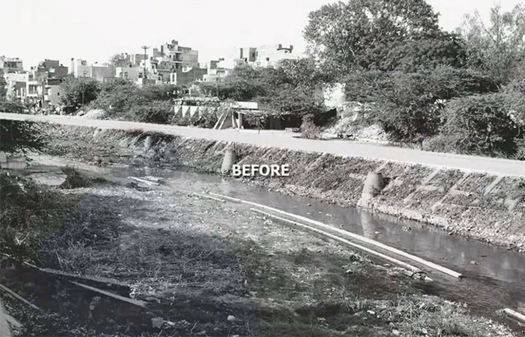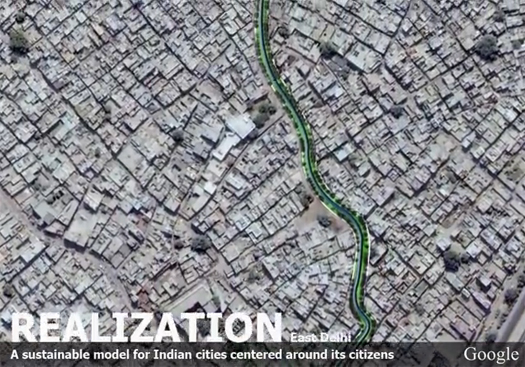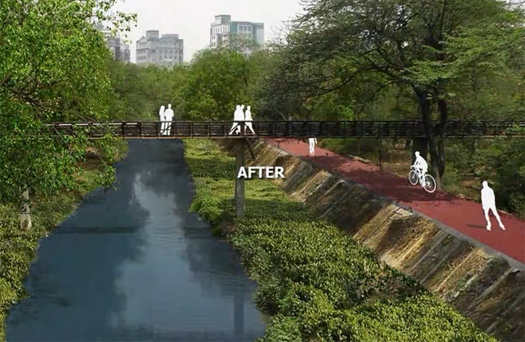
[A “nullah” in Delhi, via the Delhi Nullahs Project]
I ran across the Delhi Nullahs Project — launched by Indian architecture firm Morphogenesis, and, in particular, Manit Rastogi, one of the firm’s principals — a few days ago, via @namhenderson. The “nullahs” were originally constructed as drainage channels by the Tughlak dynasty in the 14th century, and are now open sewers draining that modern megacity into the Yamuna, in such poor condition that the city government is contemplating a plan to fully entomb them beneath concrete slabs, so that the stench and filth of the sewage is hidden as it travels the nullahs towards a massive new wastewater treatment plant on the Yamuna.

[A revitalized nullah weaves through East Delhi, offering public space, recreational opportunities, and a pedestrian/cycle corridor uncontested by motor traffic, via Delhi Nullahs Project]
The project proposes instead that the nullahs could serve both as a decentralized wastewater treatment system — using bioremediation and source-point treatment facilities to cleanse wastewater before it enters the nullahs, while distributed rainwater collection cisterns feed into the system through the estimated fifteen thousand subsidiary channels, and the increased flow of cleaned water is infiltrated to recharge depleted aquifers — and as an alternative transportation infrastructure, by providing pedestrian and cycling routes along the nullahs to connect neighborhoods and business districts to public transit corridors. Ideally, this network would then become a space for recreation, making the city at once healthier ecologically and more liveable for its inhabitants, regardless of economic status.

[A nullah carrying clean water, re-vegetated, and used as a pedestrian/cycling corridor, via Delhi Nullahs Project]
While the plan strikes me as eminently reasonable and practical — Morphogenesis is not proposing anything particularly outlandish, and working entirely with established technologies towards goals that seem virtually indisputably positive — the difficulty, of course, which the team and project has encountered is gaining leverage in disinterested political and bureaucratic systems for a plan which deviates, however slightly, from established civil engineering norms (PDF article).


interesting find nam/mammoth. i wanted to find out more details about the project (for instance, keeping the sewage out of the nullahs at the source- does that mean equipping every single residence and every street end with some new device!!??) but, unless i missed something, it seems details are sketchy. and it seems like they could use this to really examine the street and hydrology networks which are adjacent. i would assume they are critical to it’s success. right now, it seems fairly superficial, at least from what i could see at their website.
nonetheless, it is an idea that can capture the popular imagination and i like the multimedia, web 2.0 approach they are taking to build consensus and raise awareness.
i would agree, wholeheartedly, of course, that negotiating the governmental bureaucracy and interfacing with the public is the key issue, and one that landscape/architects are going to have to get better at if we want to really get involved in rethinking infrastructure.
faslanyc:
Certainly what’s available online is sketchy — I’m hoping that, since they’re talking about implementing three pilot landscapes, there’s more work that’s been done behind the scenes than what’s on show here, but the renderings that are available are indeed, as you say, superficial.
What interested me most about the project was (a) the location/authorship (not Western, and being undertaken by a local firm) and (b) the amount of work which they appear to be putting into, as you also say, negotiating bureaucracy and interfacing with the public.
You guys do the web-hosting and development yourselves?
The development, yes, such as it is (hence the crudity of the layout). The hosting, we use a third-party service.
I have been considering for a minute now to switch to my own site vs free wordpress. Who does your hosting. You still use wordpress right?
For any queries regarding the project, please email info@delhinullahs.org